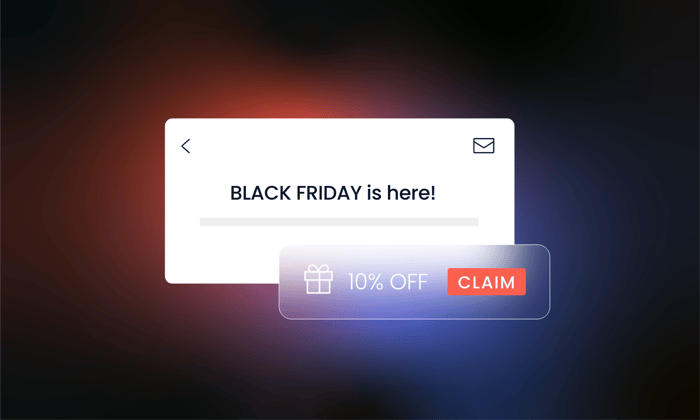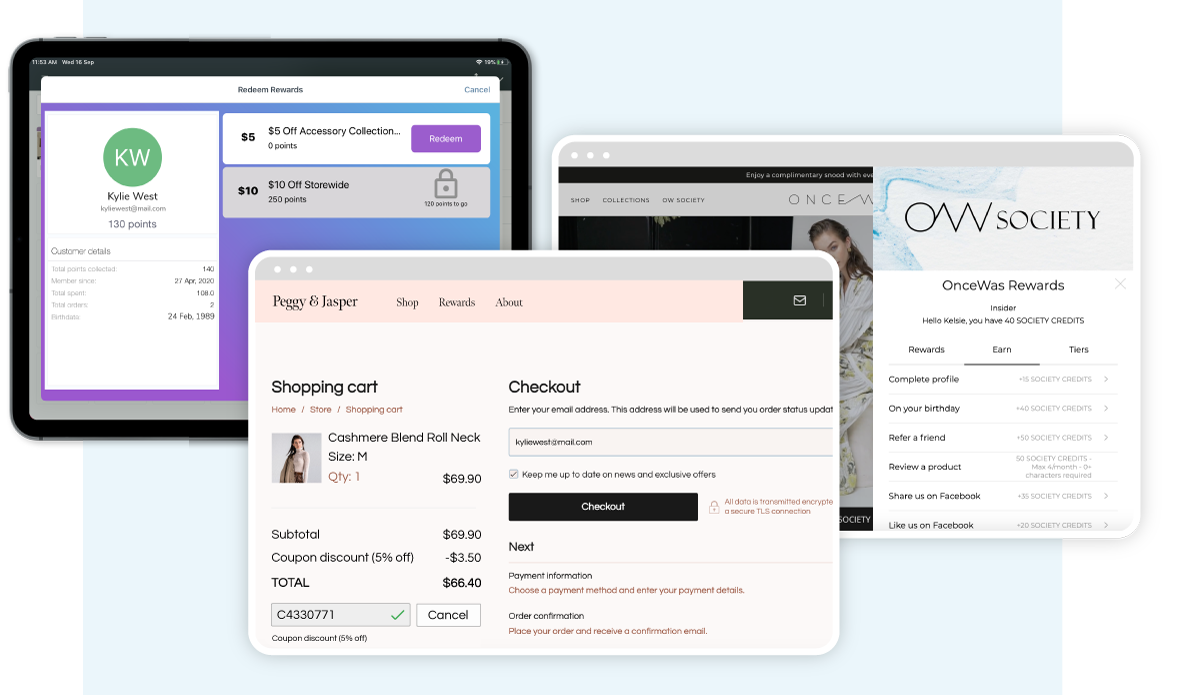
Guide to Getting Your First Key Sales in 2022
Written by Francesca Nicasio | ReadIn retail, momentum is one of the best ways to generate your first key sales.
Getting momentum and customers early on not only puts money in the bank (so you can re-invest in your growth), but it gives you the motivation to keep going.
So, how exactly can you drive your initial sales? We’ve put together 10 ideas to help you gain paying customers as you kick-off, as well as important sales KPIs and keys to building an effective sales process in your new retail biz.
Top sales KPIs to track your progress
Tracking sales KPIs is the only way to know if you are making progress in your retail business. The sooner you start tracking your progress, the sooner you will see trends in key metrics such as customer loyalty, churn rate, and how it costs to bring in a new customer.
Below are some of the best sales KPIs you should include in your analytics.
Customer Loyalty
Your loyal customers Repeat customers spend 33% more than other customers, so it is worth focusing your marketing efforts on them specifically.
Loyalty can be measured through:
-
-
- Net Promoter Scores (NPS), i.e. how likely they are to recommend your brand to someone you know
- Customer Loyalty Index surveys
- Returning customer analytics
- Loyalty programs and points redemption (customer loyalty platforms like Marsello track this for you!)
-
If you can build customer loyalty from the very first sale, they will help you build momentum as you grow.
Customer Lifetime Value
The Customer Lifetime Value KPI is how much your business can reasonably expect from a single customer. You can use this to identify your best customer segments and therefore where to focus your marketing budget.
Companies that prioritize customer experience have profits 60% higher on average than those that don’t. This emphasizes the need for ongoing customer relationships and long-term investment. Loyalty is not a once-off marketing tactic.
Customer Churn Rate
Another sales KPI is your Customer Churn Rate. A high churn rate indicates that although someone has signed up, they are not sticking around. It is measured by
For retail, KPIs that go alongside churn rates are
-
-
- Customer loyalty and NPS scores
- Retention and returning customers (do customers make one purchase and never come back?)
- Loyalty program redemption (are customers engaged with your brand’s rewards?)
-
Customer Acquisition Price
Customer acquisition price measures how much it costs your business to bring in a new customer. The lower this number, the more efficient your marketing and sales process.
Ideally, you want your average purchase order per customer to be much higher than the cost of acquiring them. This is why you should focus on customer loyalty just as much as marketing.
Average Order Value
The Average Order Value is calculated by dividing the total revenue by the number of orders placed. Tracking average order value doesn’t just give you insight into customer behavior. It also correlates with a stronger profit margin.
Using upsells, rewards points, and bonuses like free shipping thresholds are all ways that you can incentivize higher average order values when you start out.
Key elements for an effective sales process from the start
No matter what you’re selling, there are a few proven factors for success in sales. These steps integrate into any sales process, whether that is through website copy, market positioning, social media, or email marketing.
Identify customer needs clearly
Before you can make your first sale (or any sale), you need to know if your product serves your ideal customers.
This is done in the planning stage of your business. Ask questions about your product like:
-
-
- Do you have a unique value proposition?
- Have you done the market research? Is this something people ACTUALLY want or need?
- Who are your competitors? What are their measures of success?
- Why do people NEED or CRAVE your product?
- Have you done a test run to see if there is demand before investing everything in a product?
-
Putting in the effort to clearly identify your customers’ needs will set you up for success with your first few sales.
Build Rapport
Prior to launching and getting sales, it is important to start building a rapport with potential customers. 68% of customers leave a brand because they feel like you are indifferent to them. Building rapport and community is crucial!
One way you can create ongoing rapport with your potential customers is to build a loyalty program. Effective loyalty programs can help build hype and a sense of belonging for your customers which all contribute to more sales.
A good example of a loyalty program community is Our Bralette Club. They have a loyalty program that not only resulted in a 278% increase in revenue generated from program members alone but also creates a fun, inclusive community for their “Peach Party” members.
Present a solution
When you boil it down, sales and business are just identifying problems and solving them for people. Whether that's showing customers how to build their spring wardrobe, selling the highest quality dog treats on the market, or helping people get into hiking by giving great boot recommendations.
Your marketing, visual assets, storefront, and website copy should all emphasize why your product solves their exact needs.
Close the deal
Once you have done your market research, started building rapport, and have a product people want, the most important step is to actually make the sale!
We have a few tips to help increase your chances of closing the deal:
-
-
- Make your website as user-friendly as possible - According to a study by eMarketer, the only thing online shoppers like more than customer reward coupons is a quick and easy checkout process. 83% of shoppers marked this as their top priority for loyalty.
- Set up abandoned cart emails- People get distracted, people change their mind mid-payment- increase your chances of making the sale by setting up automated email campaigns for abandoned carts.
- Start collecting customer data - Set up a loyalty campaign that rewards loyal customers and gets them to sign in. This will help with retargeting and building relationships.
- Create an omnichannel marketing campaign - omnichannel marketing campaigns allow you personalize and target specific groups to increase your chance of converting them to sales.
- Sweeten the deal - How can you convert interested shoppers to paying customers? To make those first sales, consider sweetening the deal with rewards points for people who sign up and spend thresholds for things like free shipping.
-
Create upselling opportunities
Businesses with higher Average Order Values have higher profit margins. That’s just simple math! Creating upselling opportunities is a great way to increase the amount a customer spends in a single transaction.
Examples of upselling opportunities you could try out are:
-
-
- Free Shipping - Let customers know how close they are to a free shipping spend threshold
- Free Items - Give customers a free (exclusive!) gift if they spend a certain amount
- Loyalty Points - Set up a program that lets customers earn loyalty points and rewards for every dollar they spend which they can exchange for other products or exclusive experiences
- Similar Products - Give targeted recommendations for items usually brought together
- Discount Bundles - Group together similar products and offer a limited time discount to buy multiple items.
-
10 marketing ideas to help you get your first sales
Ready to make your first key sales and get that momentum going in your new retail business? Whether you’re selling online, in person, or both, these marketing ideas will get you started.
Start marketing before you launch your products
Aim to build your audience even before you officially launch your business. You can do this by creating a website or social media account, and then posting high-value content that appeals to your target audience. You could also join relevant groups or forums and start connecting with their members.
Doing so benefits you in a couple of ways. For starters, finding an audience prior to creating your product or business enables you to validate your ideas and determine if there’s a strong demand for your offerings.
What’s more, building an audience early on paves the way for a stronger launch. If you already have an email list or existing social media followers, then you can unveil your products to an audience who already knows who you are, and are thus more likely to buy from you.
Andrew Alexander, the owner of FindaBusinessIdea.com, put this strategy to work in his own business and has seen tremendous results.
“In 2011, I was making posts on niche forums, Facebook groups, and other niche websites [...] Three years later when I released a program of mine… I already had people who were familiar with my name and what I wrote about, so the content I put out there (before I even had a product) allowed me to get my first $1,200 in sales within the first few weeks of launching my business.”
2. Be clear about your Unique Value Proposition (UVP)
One of the biggest challenges when it comes to getting your first sales is standing out in the marketplace. If your company is brand new, it can be difficult to win over shoppers, particularly if you’re selling something that people can buy elsewhere.
An effective way to get around this is to identify your unique value proposition and then market to a specific niche that would benefit from your UVP. Doing so enables you to be more targeted with your messaging and positioning, which then allows you to cut through the noise, so you’re speaking directly to your niche.
Jonathan Prichard, the CEO and Founder of MattressInsider.com says that finding his business' UPV and niche helped keep his business from sinking.
“When I began my mattress company, I almost went bankrupt selling the same thing every other mattress company in America sold, which made it difficult to stick out. Luckily, I found the custom mattress size niche and was able to reposition the business before we went under,” he shared.
Jonathan’s key advice is to showcase your UPV in compelling ways.
“It’s a no-brainer that this is going to make you stand out from the crowd to draw people in for your initial sales. If you don’t stand out in the market you’re entering, you’re not going to get those sales that will keep you afloat, thriving and motivated.”
3. Tap into your existing network
Your current network could hold the key to unlocking more momentum in your business. If you haven’t done so yet, start reaching out to your friends, family, and existing supporters to see if they can help spread the word or send shoppers your way.
This step doesn’t have to be complicated. As Kathleen Cutler of Bespoke Commerce notes, you can get going with just a pen and paper.
“Write down your most connected friends and family who've bought from you in the past. Email them directly to ask who they might know who'd be interested in your eCommerce shop. Follow up with the referral leads directly with highly targeted and personalized communication.”
4. Create an engaging storefront (both online and in-person)
As a retail business, your storefront can either drive traffic and sales or send people packing. This is why it’s important to keep your window displays attractive and enticing. Here are some general guidelines to keep in mind:
-
-
- Always have fresh merchandise and themes – See to it that your storefront keeps up with seasonal trends. Update your displays every week or two with new merchandise to give customers reasons to check out your store.
- Keep elements at eye level – Decide on the products or elements that you want to draw attention to, and then position those key components at eye level. This ensures that people will immediately see the most important elements of your displays.
- Avoid clutter – Overcrowded displays can cheapen the look and feel of your merchandise. Prevent that by keeping your display clean and uncluttered. The objective is to use your best products to attract customers, and encourage discovery while they’re inside your shop.
-
Here's a great example of a display following the above best practices. Created by Smack Bang, the window display incorporates clear links to the brand colors and aesthetic (which match the online store) and showcases Smack Bang's outstanding pet products by cleverly displaying them at various levels.
They've even added links to their store and socials with window decals which is a clever way to encourage social media engagement – something they reward with their customer loyalty program.
For eCommerce stores, your homepage is the online equivalent of a window display, and the same design principles apply. Be sure to showcase your seasonal products and new arrivals, and avoid cluttering up the page with unnecessary information.
Anna Beck, a Shopify Plus-powered jewelry retailer, has mastered a well-branded, visually appealing online user experience. Their online store is always tastefully-designed with a beautiful homepage banner featuring their high-quality product photography.
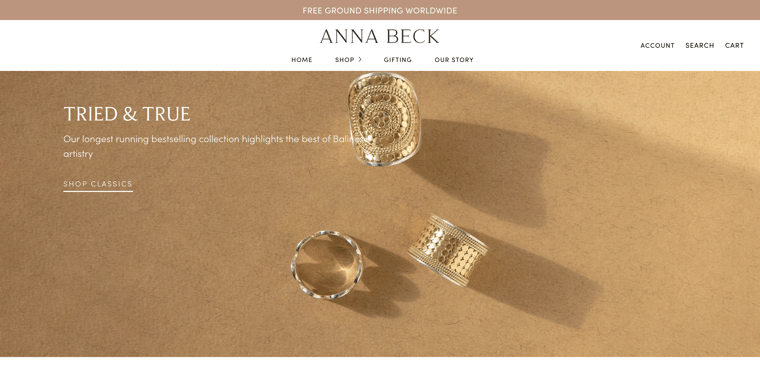
With their logo at the top of the page, a simple set of navigation options, and clear but unobtrusive banners, Anna Beck's online store feels inviting and enjoyable to explore – something that's essential for 'E-tail' success.
5. Collaborate with other companies
Consider tapping into the audiences of other retailers and brands. Identify non-competing companies that share your target customers and see if you can team up with them. Collaboration between brands and retailers is becoming an increasingly popular strategy, particularly when it comes to eCommerce companies teaming up with physical retailers.
Case in point: Australian women's ethical surf brand Salt Gypsy. Salt Gypsy started as an eCommerce store specializing in women's surfwear (swimwear that meets the needs of surfers). While Salt Gypsy has a bricks-and-mortar location, they've been able to grow their brand and make waves into new areas by branching out into technical surf equipment – namely, surfboards!
Now, numerous stores in Australia and locations around the world have teamed up with Salt Gypsy to sell their merchandise – and their boards (designed specifically for female surfers) are flying off the racks! Sometimes, the Salt Gypsy team gets a chance to pop into one of these locations like they did at Byron Bay surf store, Surfection.
And the Surfection team is quick to cross-promote Salt Gypsy too! It's exactly this kind of co-marketing that creates life-long customers from just one sale!
6. Team up with influencers
Research shows that 92% of consumers trust influencers more than traditional celebrity endorsements, which means that building relationships with the right individuals can pay off for your brand.
If it makes sense for your business, start identifying social influencers who can amplify your messages. Use tools such as Peg, Reachbird, and Scrunch to find the right people and create outreach campaigns.
You can engage influencers through a number of ways, including:
-
-
- Free products
- Content collaborations
- Sponsored posts
-
For best results, throw in a special offer or discount that influencers can promote to their followers. That’s what Lokus Nutrition did when they ran their influencer campaign.
“We targeted Instagram users with audiences that matched our desired customer. We reached out to them directly and engaged an Influencer Marketing Agency to help,” explained Paul Miller, president at Lokus Nutrition. “We [then] offered a 10% discount code for our Instagram influencers to use in their posts.
7. Tap into relevant groups and websites
In addition to sending freebies or discounts to influencers, see if you can apply the same strategy when reaching out to websites and social media groups.
According to Paul, they also reached out to Facebook groups whose members matched their target market and offered a discount for all group members.
The Lokus Nutrition team also reached out to websites that were coming up with gift guides, and sent those sites free products to sample, review, and include in their guides.
Consider doing something similar in your business. Identify groups, forums, or websites that are frequented by your target audience, and then explore partnership opportunities with them.
8. Encourage referrals
Create momentum and drive additional sales by encouraging your current customer base to refer your brand to their network. To streamline this process, use a referral program that makes it easy to track referrals and rewards.
Carolina Lifestyle, a women's clothing retailer, implements this strategy quite well through their customer loyalty program. Carolina Lifestyle's referral program instantly rewards their customers with 100 loyalty points (the equivalent of $10 off in-store) for every friend who successfully makes a purchase.
The program not only attracts new shoppers, but it lets the brand reward their existing customers, which builds goodwill and brand loyalty in the process.
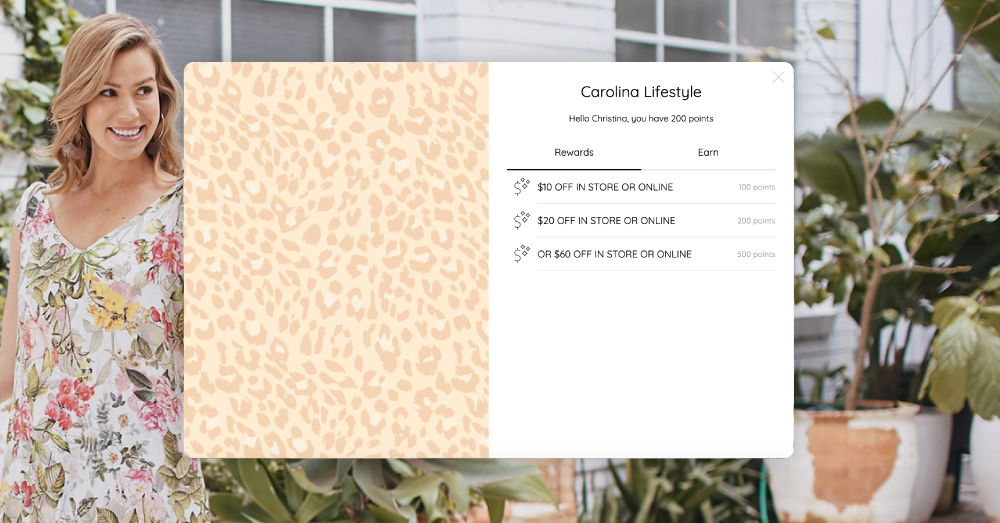
Marsello lets you automate the referral process with instant unique URLs for different social media platforms, email, and SMS, then reward customers for successfully referring their friends who complete a purchase.
9. Consider third-party online marketplaces
It’s worth considering if marketplaces like Amazon, Etsy, and eBay are good sales channels for your brand. These websites reach hundreds of millions of users daily, so with the right marketplace strategy, you can drive additional sales.
Each website is different, but here are a few general pointers for how to succeed in online marketplaces:
-
-
Craft compelling listings – Make your product listings as compelling as possible by using attractive images and rich media that showcase your items from various angles. You should also craft unique and compelling copy to effectively communicate the features and benefits of your items.
-
Optimize your listings for search – You want your products to show up on relevant searches, so optimize your listings by incorporating targeted keywords in your titles and descriptions. Just remember not to overdo it! The key is to write for people, not bots.
-
Build up a strong seller reputation – Marketplaces like Amazon, Etsy, and eBay strongly favor sellers with high ratings and reviews. So, strive to build a stellar reputation by selling high-quality products at fair prices, and by providing excellent customer service.
-
10. Win back lost sales
Are shoppers leaving your website without completing their purchases? Don’t let those potential key sales slip away. Implement abandoned cart email campaigns to remind shoppers about the items left in their basket.
Take a leaf out of OnceWas’ playbook. Whenever someone adds an item to their cart but leaves without completing the sale, OnceWas' Marsello-powered marketing triggers an automated email flow to give the customer the opportunity to finish their purchase and even throws in the added incentive of a 10% discount.
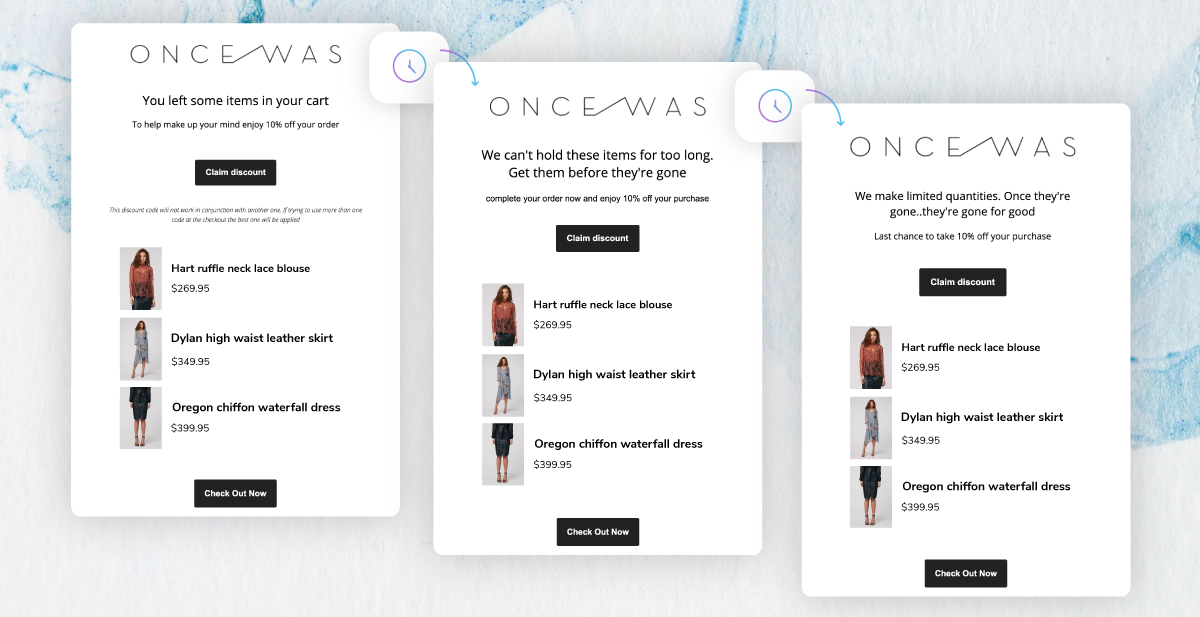
Automated win-back flows are just one of the many ways you can implement automation into your marketing to help you get more and more sales and scale your business. Book a demo with one of our team to learn more about marketing automation and all the other features available with Marsello.
Final words
Gaining your first key sales may seem daunting, especially if you’re just starting out, but it’s completely doable! With a bit of resourcefulness and creativity, you can start winning over those initial customers and obtain the momentum you need to keep going.
Need a hand tracking sales KPIs, automating your marketing campaigns, and building engaging loyalty programs to keep those sales rolling in? Marsello is the all-in-one retail platform to help you start, grow, and scale with ease.





